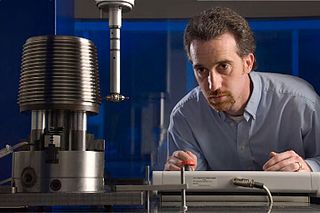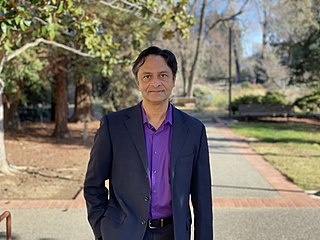Related Research Articles

Shun Fat Supermarket is a Chinese Vietnamese American supermarket chain in the San Gabriel Valley region in California, Sacramento, California, San Pablo, California, Las Vegas, Nevada, Portland, Oregon and Garland, Texas.
A strawberry festival is an event and celebration in many towns in North America. In most instances, areas around these towns are, or have been, deeply involved in the production and marketing of strawberries, and the festivals are usually held in late spring around the time of the strawberry harvest. Such festivals generally involve a parade and other community events and the consumption of the fruit, and may attract visitors from other places.

Armand Paul Alivisatos is a Greek-American chemist and academic administrator who has served as the 14th president of the University of Chicago since September 2021. He is a pioneer in nanomaterials development and an authority on the fabrication of nanocrystals and their use in biomedical and renewable energy applications. He was ranked fifth among the world's top 100 chemists for the period 2000–2010 in the list released by Thomson Reuters.
SPIE is an international not-for-profit professional society for optics and photonics technology, founded in 1955. It organizes technical conferences, trade exhibitions, and continuing education programs for researchers and developers in the light-based fields of physics, including: optics, photonics, and imaging engineering. The society publishes peer-reviewed scientific journals, conference proceedings, monographs, tutorial texts, field guides, and reference volumes in print and online. SPIE is especially well-known for Photonics West, one of the laser and photonics industry's largest combined conferences and tradeshows which is held annually in San Francisco. SPIE also participates as partners in leading educational initiatives, and in 2020, for example, provided more than $5.8 million in support of optics education and outreach programs around the world.
Precision Castparts Corp. is an American industrial goods and metal fabrication company that manufactures investment castings, forged components, and airfoil castings for use in the aerospace, industrial gas turbine, and defense industries. In 2009 it ranked 362nd on the Fortune 500 list, and 11th in the aerospace and defense industry. In 2015 it ranked 322nd overall and 9th in the aerospace and defense industry. In 2014 it ranked 133rd on the S&P 500 based on market capitalization. In January 2016, the company became a wholly owned subsidiary of Berkshire Hathaway. Before that event, it used to be one of the three Fortune 500 companies headquartered in Oregon.

ESCO Group LLC is a manufacturer of engineered metal wear parts and components for industrial applications—including mining and construction. Since 1913, the company, which is a division of Weir Group PLC, has been headquartered in Portland, Oregon, USA.

Precision engineering is a subdiscipline of electrical engineering, software engineering, electronics engineering, mechanical engineering, and optical engineering concerned with designing machines, fixtures, and other structures that have exceptionally low tolerances, are repeatable, and are stable over time. These approaches have applications in machine tools, MEMS, NEMS, optoelectronics design, and many other fields.

RabbitEars is a website that provides information on over-the-air digital television in the United States, its territories, protectorates, and border areas of Canada and Mexico. It lists network affiliations and technical data, and also covers stations with Descriptive Video Service, TVGOS, UpdateTV, Sezmi, Mobile DTV, and MediaFLO RabbitEars maintains a spreadsheet of current television stations.
The International Conference on Environmental Systems, or ICES, is an annual technical conference focusing on human spaceflight technology and space human factors. Session topics include: Environmental Control and Life Support Systems (ECLSS), thermal control, life sciences, extra-vehicular activity (EVA) systems, space architecture, and mission planning for exploration.
Ann Catrina Coleman FIEEE FOSA is a Scottish electrical engineer and professor at the University of Texas at Dallas specialising in semiconductor lasers.

Cleveland Salter Rockwell was an American topographical engineer, cartographer, military officer, investor, and landscape painter. He spent his professional career as a survey engineer in the United States Coast and Geodetic Survey. Rockwell conducted numerous coastal surveys and mapped harbors and river systems on the Atlantic and Pacific coasts of the United States. He also surveyed areas in South America. During the American Civil War, Rockwell served as a captain in the Union Army. After retiring from the Coastal Survey, he became a successful investor and landscape painter. Today, Cleveland Rockwell's topographical maps are important historical documents and his art work is well known in the Pacific Northwest.
The Association of Environmental & Engineering Geologists (AEG), is the principal American association of professionals in the fields of geotechnical engineering, engineering geology, soils engineering, hydrological engineering, and environmental geology. The association also includes geologists, civil engineers, structural engineers, ecologists, petroleum engineers and others in fields relating to engineering geology and its effects on the environment.
Electro Scientific Industries, Inc. (ESI) is an American high technology company headquartered in the Portland, Oregon, metropolitan area, specifically in Beaverton, Oregon, since 2021, but from 1963–2021, it was based in the unincorporated Cedar Mill area just north of Beaverton. ESI is a developer and supplier of photonic and laser systems for microelectronics manufacturers. Founded in 1944, it is the oldest high-tech company in Oregon. Along with Tektronix, and later Intel, it has spawned numerous technology-based companies in the Portland area, an area known as the Silicon Forest. From 1983 to 2019, shares in the company were publicly traded on NASDAQ, under the ticker symbol ESIO.
Andrea Alù is an Italian American scientist and engineer, currently Einstein Professor of Physics at The City University of New York Graduate Center. He is known for his contributions to the fields of optics, photonics, plasmonics, and acoustics, most notably in the context of metamaterials and metasurfaces. He has co-authored over 650 journal papers and 35 book chapters, and he holds 11 U.S. patents.
Chih-Kung Lee is a Taiwanese mechanical engineer. He received his B.S. degree in civil engineering from National Taiwan University and then obtained his M.S. and Ph.D. degrees from Cornell University, majoring in theoretical & applied mechanics, with a minor in physics. He is known as the inventor of modal sensors and actuators. In the past, he has been an advisor to the Ministry of Education, Ministry of Economic Affairs and various other governmental agencies, as well as the director general of engineering & applied sciences at Taiwan's National Science Council (NSC). Currently, he is the chairman of Industrial Technology Research Institute (ITRI) and Institute for Information Industry (III). He is also a distinguished professor of the Graduate Institute of Electronics Engineering, the Institute of Applied Mechanics (IAM) and the Dept. of Engineering Science & Ocean Engineering at National Taiwan University.
Chennupati Jagadish, an Indian-Australian physicist and academic, is the President of the Australian Academy of Science, and a Distinguished Professor of Physics at the Australian National University Research School of Physics. He is head of the Semiconductor Optoelectronics and Nanotechnology Group which he established in 1990. He is also the Convener of the Australian Nanotechnology Network and Director of Australian National Fabrication Facility ACT Node.
James J. Coleman is an electrical engineer who worked at Bell Labs, Rockwell International, and the University of Illinois, Urbana. He is best known for his work on semiconductor lasers, materials and devices including strained-layer indium gallium arsenide lasers and selective area epitaxy. Coleman is a Fellow of the IEEE and a member of the US National Academy of Engineering.

M. Saif Islam is a Bangladeshi-American engineering professor of Electrical and Computer Engineering at the University of California, Davis.
Xiuling Li is a distinguished electrical and computer engineering professor in the field of nanostructured semiconductor devices. She is currently the Temple Foundation Endowed Professorship No. 3 in Electrical and Computer Engineering and Fellow of the Dow Professor in Chemistry at the University of Texas at Austin. Previously, she was a Donald Biggar Willet Professor in Electrical and Computer Engineering and Interim Director of the Nick Holonyak Jr. Micro and Nanotechnology Laboratory at the University of Illinois at Urbana-Champaign.
References
- ↑ http://www.photonics.com/directory/SocietiesUniversities/Details.aspx?SocietiesUniversitiesID=10, Photonics.com, Societies and Universities, American Society for Precision Engineering(ASPE), Retrieved February 3, 2011.
- ↑ "The Japan Society for Precision Engineering". Archived from the original on 2010-12-21. Retrieved 2010-06-04., The Japan Society for Precision Engineers, Retrieved February 3, 2011.
- ↑ http://www.imts.com/conference/partner/p_aspe.cfm Archived 2010-10-04 at the Wayback Machine , International Manufacturing Technology Show / Sept. 10-15, 2012 IMTS 2012 - International Manufacturing Technology Show , Forum Educational Description, Retrieved February 3, 2011.
- ↑ http://www.aspe.net/about/index.html Archived 2011-04-13 at the Wayback Machine , About ASPE.., Retrieved February 3, 2011.
- ↑ "Precision Engineering - Journal - Elsevier". www.journals.elsevier.com. Retrieved July 7, 2016.
- ↑ http://www.cirs.net/prix/awards.php?id=1605, Prizes and Awards, International Center for Scientific Research, Retrieved February 3, 2011.